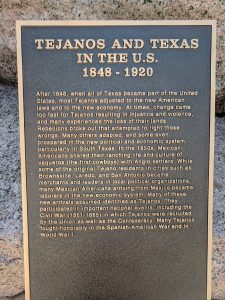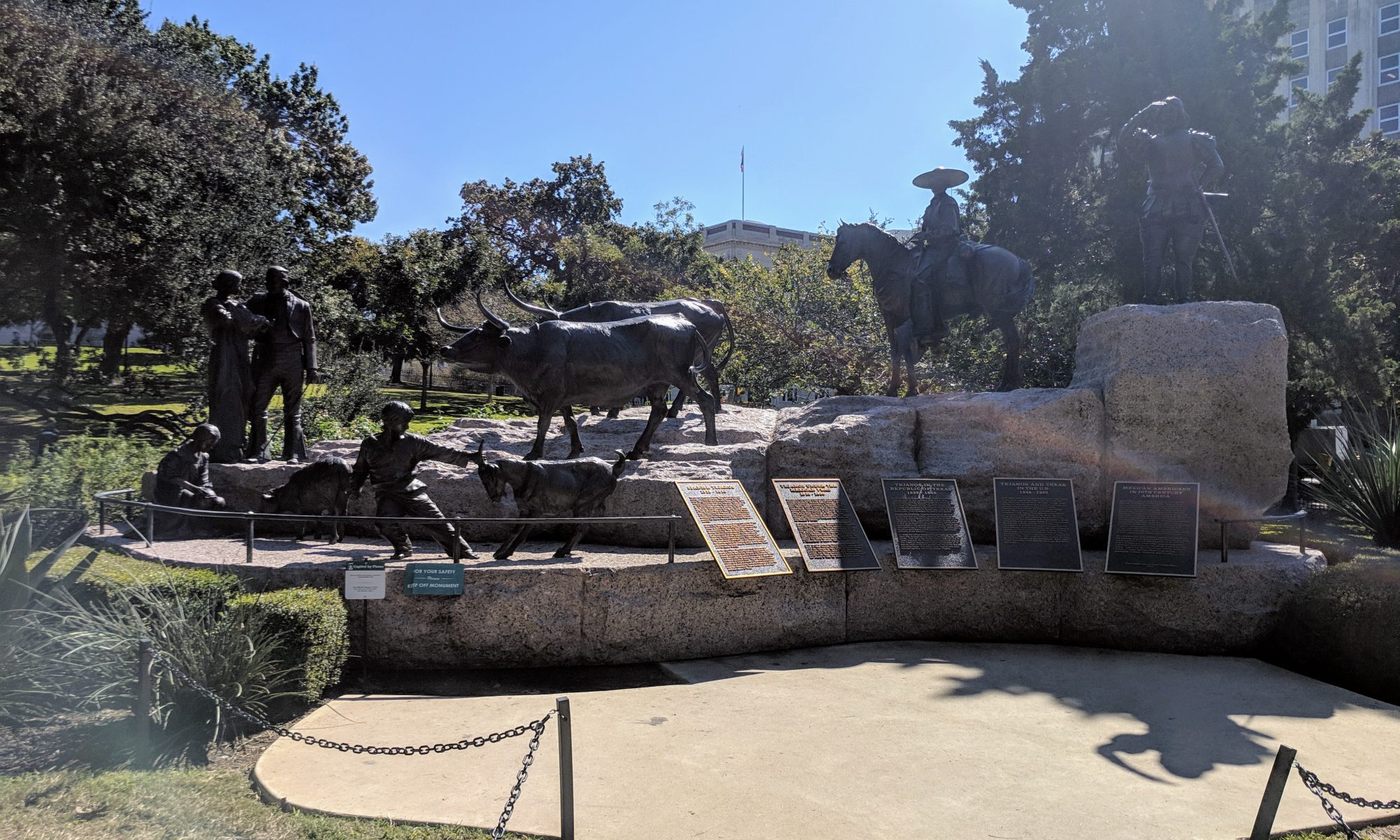After reading a Publicly Historians blog post by my colleague Gabriel Cohen, I knew that if I ever just so happened to be in Austin, Texas, and hanging around the capitol building, I may as well take a gander at the Tejano Monument. I didn’t think I’d meet those conditions during the Fall of 2018, but lo and behold, I did. And I have a few things to say about it.
A Few Things to Note
The Tejano Monument is well-deserved, and I’m glad that it exists– don’t get it twisted on that account. Representation is important, and Tejanos are the foundation of Texas. Credit should be given where credit is due, and I think we have quite enough Civil War statues. It’s shameful that we waited so long to give the measliest credit to the true pioneers that settled Texas long before any anglos set foot in what is now the Lone Star State. What I don’t appreciate is the manner that it was executed, and although this is common practice, it undercuts what should be a huge celebration.
The Passive Voice
Using passive voice when describing historical events doesn’t always make the parties involved or happenings unclear. We know what happened, and we know who did what simply because we are able to infer using the information provided and our prior knowledge in most cases. Passive voice does not turn history into gibberish, but it lets the speaker get away without admitting fault. That is exactly what the five plaques at the Tejano Monument does.

On the five plaques that accompany the statues of the monument, it seems that misfortune befalls the Tejanos as the anglo settlers arrive. They lose their land, “injustice and violence” happen, and rebellions break out for some reason that I just can’t place. I can’t help but wonder who was instigating this violence, taking the land, creating the injustice. Who were the Tejanos rebelling against? I don’t think anyone genuinely doesn’t know who was doing all of this, but I can’t help but think modern Texans should own up to it.
Anglo settlers stole the land of Tejanos. Anglo settlers subjugated Tejanos. Anglo settlers created gaps in equality that we are still atoning for to this very day. “Tejanos and Texans in the U.S.” reads “At times, change came too fast for Tejanos…” Yeah, that’s putting it lightly.
The Takeaway
You do not atone for historical injustice until you admit that what happened was wrong. Modern Texas is not built on the ideal of an equitable society, it is built on the backs the Tejanos that had everything ripped from them, including their humanity. To heal our society in all cases, we have to look back and try to understand what happened– who reaped the benefits, and who those benefits were snatched from. Someone has to say it, and it is painfully clear that our state monuments won’t.


Wow, this was exciting to read. I think you and I are absolutely on the same page on this subject. You did a brilliant job of illustrating the difference between active and passive voice.
The truth is that Anglo-American settlers pillaged and killed Tejano settlers. What is often said is that ‘Tejano settlers were beset by violence’ or something mealy-mouthed like that. On a generous day they might even throw in a ‘by Anglos’ at the end of that sentence, but the pain of the victims and the responsibility of the perpetrators is lost in translation.
After we discussed this the other day in Dr. Wieck’s class, I spent a while thinking about what we talked about and the books I’ve read that utilize this passive voice. I think I know why it’s used so often.
It’s sterile. When you use a passive voice to describe painful historical events, there is less pain and less guilt. There’s also less incentive to learn from tragedy and to re-examine our history.
Thanks for this post, I think you gave a voice to a lot of us with it.
Oh yeah – what did you think of the location? My reading about it before is likely entirely different from being there. Do you think the location does the monument justice? Or more importantly, the intent of the monument?
Honestly, most of what you’ll see on the grounds of the capitol is scattered on the lawn, or something you’ll see milling around on the various lawns. I don’t think the location is too much of an issue. Thanks so much for your responses!
This was such a great read and I appreciate how blunt you are about everything, starting with the title. I agree with Gabriel about your examination of the passive and active voice, great assessment and reminder about why we need to utilize this tool within our own writings. However, I think relying on the readers prior knowledge to fully understand events is a dangerous practice. In reading “Decolonizing Museums” by Amy Lonetree, I was shocked to learn that many indigenous community members were not even aware of their own histories. And in Texas, Hispanic and Tejano heritage are not heavily covered in primary or secondary schools, so I wouldn’t be surprised if many people are unaware of these histories, especially with a tendency to gloss over the potentially controversial aspects as you have pointed out. Another awesome post Glory!
You’re completely right! It’s wishful thinking to assume that everyone will have an idea of their history orunjust histories of our states and nation. This just means its even more important to be crystal clear when detailing historical events. Thanks for the response!
This is a very good read. You point out a big issue with a lot of memorials that deal with events where one group is taking oppressive actions against another, especially when the oppressors still wield power. Some people have a real problem dealing with the sins of their fathers. There are many examples of memorials that do not tell the whole story. I feel that the formula for tragic memorials should be something like “This bad thing happened here. It was tragic, let’s make sure nothing like it happens again.” Covering up history does more harm than good.
Great post Glory with solid points well made!
I wonder who was responsible for coming up with the copy of the plaque. I’m sure that it had to pass many different sets of eyes before it was cast in bronze.
Using the example of the Sand Creek Massacre and the plaques were wrong, I wonder how this will be righted in the future and how long that might take…
Also, after I posted my comment I looked up some more information on the Texas State Historical Association online here:
https://tshaonline.org/handbook/online/articles/ggt02
Quoting from the link listed above:
“In addition to the ten statues, the Tejano Monument incorporates five bronze-relief plaques mounted along the front edge of the monument base. The plaques were intended not only as interpretive aids but also to serve as an unobtrusive barrier to unauthorized intrusion onto the monument. The plaques are 22 inches wide and 33 inches high. Each contains approximately 400 words of text in deep relief cast bronze and relates to a major historical period in Tejano history. The titles and historical periods are “Spanish Tejanos (1519–1810),” “Tejanos Under the Mexican Flag (1810–1836),” “Tejanos in the Republic of Texas (1836–1848),” “Tejanos and Texas in the U. S. (1848–1920),” and “Mexican Americans in 20th Century America.” The historical text for the plaques was written by prominent scholars with extensive credentials in their respective fields of Texas history.”
Notice the last sentence. I’m still not sure which prominent scholars were consulted but I’m sure there’s more to the story there.
Prominent scholars, huh? Interestingly vague. Thanks for following up!!
Glory, your blogs are always on point. I really appreciate the voice you use in this blog and the topic that you chose to write about. I think it is absolutely insane the amount of historical amnesia some Texans have oh-so-conveniently have forgotten and it seems refuse to fully acknowledge where credit it due
Lately it feels like its a cleanup effort for young historians– if we don’t take the initiative to do right by the oppressed, the shadow cast by those already dead will perpetuate these dark times.
Right. I totally agree. I have had many comments from others about being a killjoy but I think this our time to step up. There are so many strong students that have the courage to take a stand and make a difference